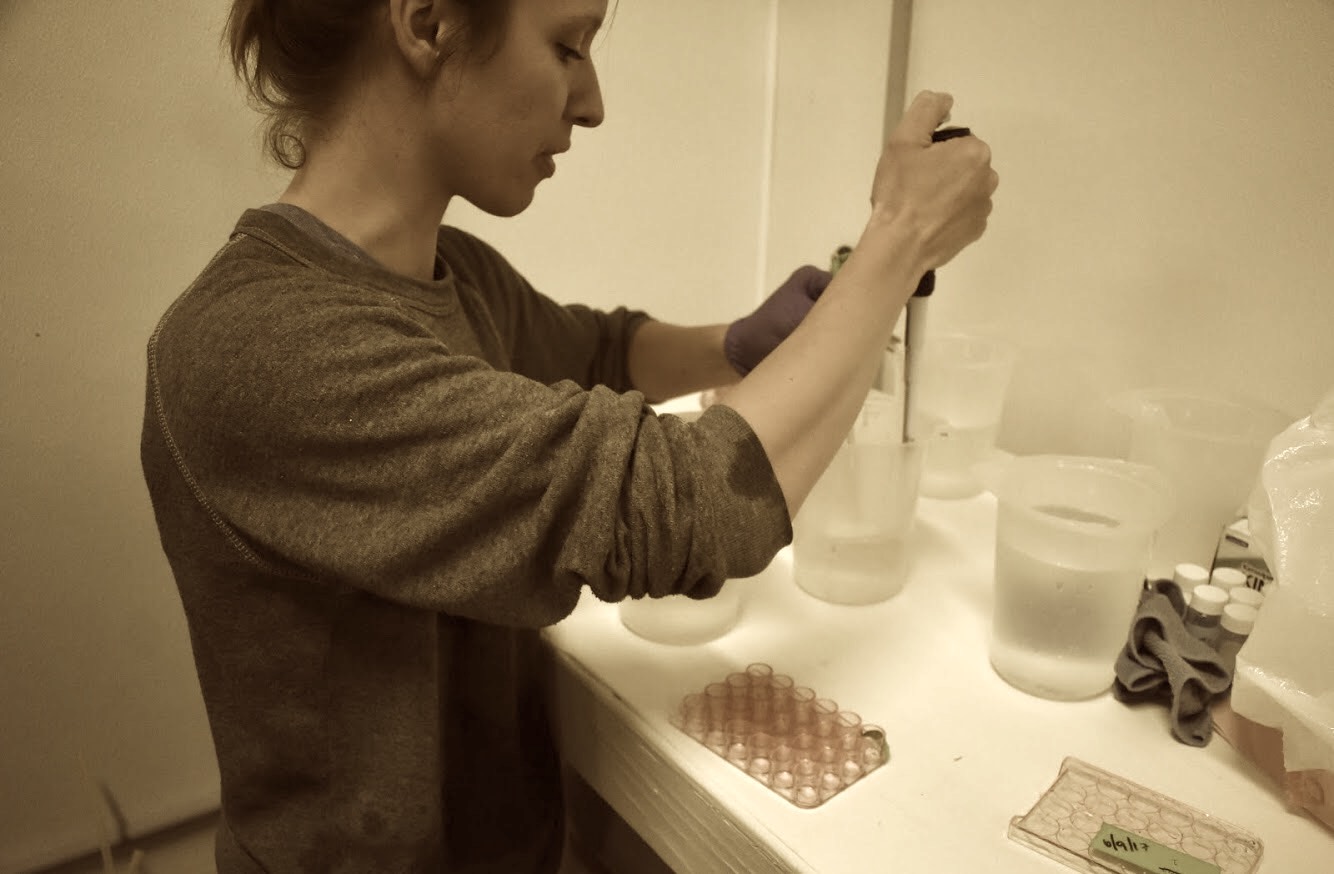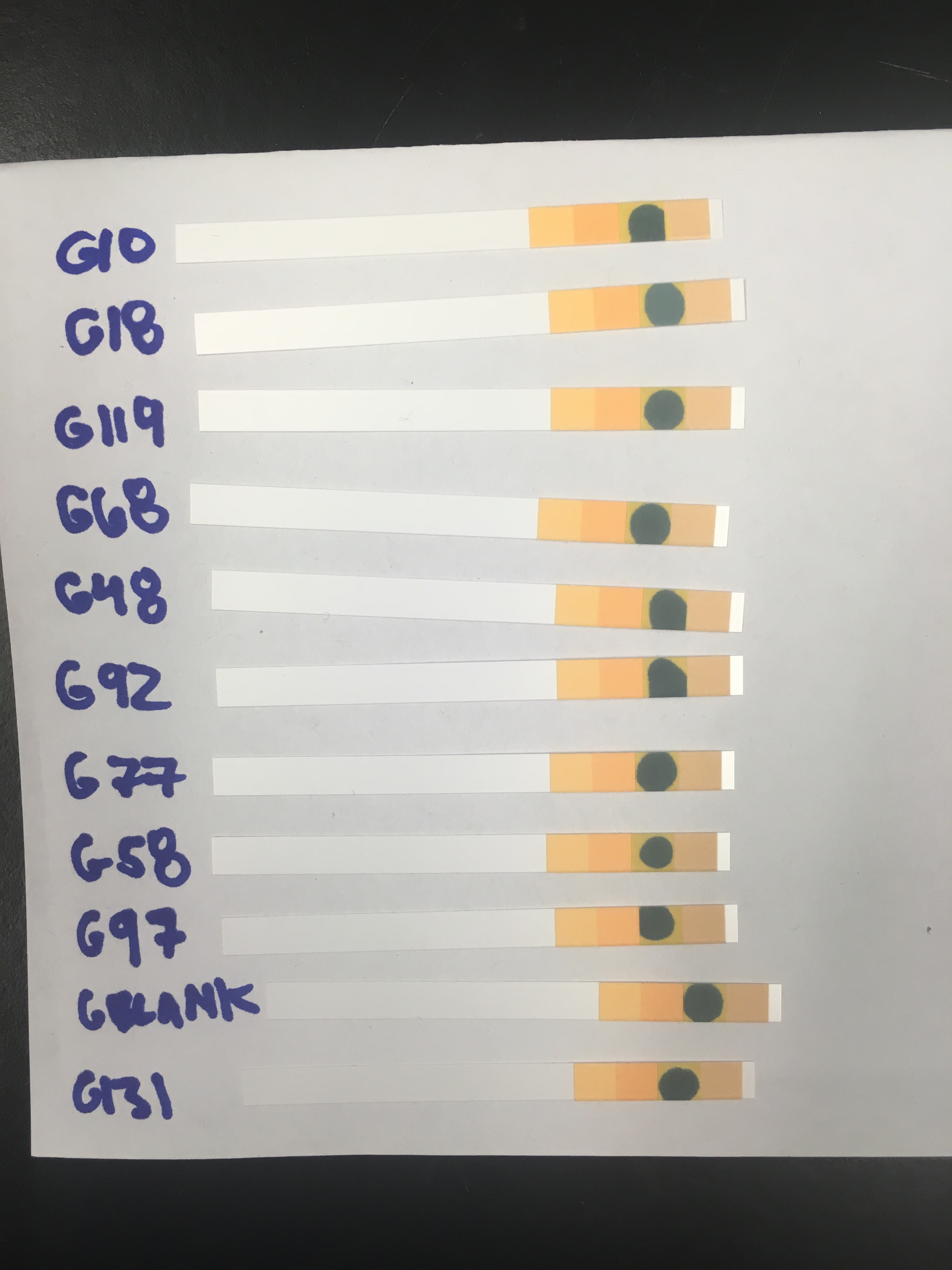Lab day 4 - Digestion
Making peptides via Mini-Trypsin Digestion
Today involved lots of reagents & incubations. Rhonda made several of the reagents that we needed (stored in the -80), so we were able to use those.
Step 1: Make 10mL of the 50mM ammonium bicarbonate in 6M urea (must be used within 24hr)**
- Dissolved 39.53mg NH4HCO3 into 5ml nanopure in falcon tube. Vortexted to dissolve.
- Added 3.6g Urea, vortexted to dissolve.
- Poured solution into graduated cylinder, and topped off with nanopure to 10ml. Vortexted.
Step 2: Turn on heating block, and set to 37degC. Verified temperature with thermometer.
Step 3: Prepare 30ug of Samples:
NOTE: In the homogenization step we added 500ul of 50 mM NH4HCO3 + 6M urea solution, homogenized, and used the entirety of that mixture in the next step, rather than pulling 150ul of the supernatant off. This was a mistake; we should have only added 100ul of 50 mM NH4HCO3 + 6M urea solution. This means that our protein concentration is relatively low. We cannot simply evaporate down to 100ul, since that would leave too much Urea in the solution. Instead, we are paring down the sample to only run 30ug of protein through the MS.
- Remove samples from -80C & one aliquot of previously-made TCEP; put on wet ice.
- Vortex samples, and pipette the equivalent of 30ug of protein to a new labeled snaptop centrifuge tube.
- The protein concentrations were determined by the BCA assay on 12/13/2016.
- Diluted each sample to 100ul using the 50mM NH4HCO3 in 6M urea. Vortex.
- *IMPORTANT Note: I accidentally added 57.4ul of 50mM NH4HCO3 in 6M urea to original sample G18. Whoops. This dilutes the protein concentration, and needs to be considered if running this sample through the MS again.
- Add 6.6ul of 1.5M Tris pH 8.8 to each sample. The Tris we used was made by Rhonda on 11/16/2016.
Step 4: Add TCEP & incubate:
- Add 2.5ul of 200mM TCEP (also made by Rhonda) and vortex.
- Check pH to make sure it is still basic (>7.0) by pipetting 2ul from each sample to a pH test strip. Just like Rhonda, I added the drop to the green square as the color will turn bluish if over pH7-8. They all looked OK.
- Put the 22 samples in the 37C heating block for 1 hr.
- Return the remaining, original samples back in the -80C.
Step 5: add IAA and incubate
- Pull 3-200ul IAA aliquots from the -80C and wrap the tubes in foil to keep out of the light. Defrost.
- Add 20ul of IAA to each sample.
- Incubate for 1 hr in the dark at room temp.
Step 6: Add DTT and inclubate
- Pull 3- 200ul DTT aliquots from -80 and defrost; add 20ul to each sample.
- Incubate for 1 hr at room temp.
Step 7: Add Lys-C and incubate:
- Pull 1- 20ul Lys-C aliquote out of -80; defrost.
- For our 30ug protein samples, add 0.55ul to each sample which is a 1:30 ratio of enzyme to protein.
- Incubate for 1 hour at room temp.
Step 8: while samples are incubating, make 25 mM NH4HCO3:
- Volume needed: 17.6mL; must be used within 24 hrs
- Make a 25ml solution:
- MW: 79.06g/mol; (79.06g/mol)x(1mol/1,000mmol)x(25mM/1L)x(1L/1,000ml)x(1000mg/1g)x 25ml = 49.4mg of NH4HCO3 for 25ml
- Dissolve 49.4mg NH4HCO3 in 20ml nanopure. Vortex and add additional nanopure to reach 25ml.
**Step 9: Add 800 µl 25 mM NH4HCO3 and 200 µl HPLC grade methanol to each tube.
Step 10: Prepare trypsin & add to samples:
- Pull the number of trypsin bottles needed out of -20; (1.1ug/sample with 30ug of protein)*22 samples = 24.2ug; need 2 bottles
- Add 20 µl nanopure to each 20 ug bottle of trypsin and vortex lightly. This creates a 1ug/ul concentration of Trypsin.
- Add 1.1ul Trypsin (1:30 enzyme:protein ratio); vortex.
Step 11: Incubate
- Options are: 1) overnight at room temperature or 2) for 4 hours at 37°C. We chose overnight @ room temp.
Written on December 13, 2016

